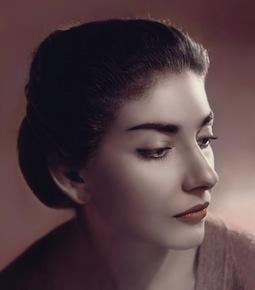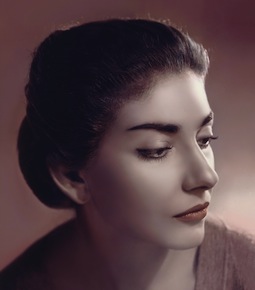
Maria Callas: The very name conjures up a voice and a reputation of near-mythic proportions. After launching her career as an unattractive, overweight soprano with a sensational voice, she transformed herself into a slim and glamorous diva whose mesmerizing stage presence and increasingly scandalous behavior earned her a frequent place on the covers of international magazines.
Her life story is part of her legend. Born in New York City in 1923, Callas was at the height of her fame when she abandoned both her career and her husband and manager, Giovanni Battista Meneghini, in favor of a high-society lifestyle on the arm of one of the world’s wealthiest men, shipping magnate Aristotle Onassis. After a shortlived comeback heartbreak followed when Onassis, whom she had hoped to marry, rejected her only to take up with and marry presidential widow Jacqueline Kennedy.
In the years thereafter, her qualified success in a nonsinging role in Pier Paolo Pasolini’s film of Medea; a failed attempt at stage directing; too few master classes; a mostly disastrous final concert tour of 1973–1974 with her ex-stage partner and sometime-paramour, tenor Giuseppe di Stefano; and her increasing isolation, dependence on pills, and death in 1977 from what may have been a drug-induced heart attack — all compose a real tragedy of operatic proportions.
Contributions and Controversy
The Callas voice itself was always the subject of debate. Some music lovers found its combination of dramatic power, coloratura agility, and weight at both ends of the spectrum unprecedented in their lifetimes. Others found it hard on top, veiled in the middle, and lacking in beauty. While almost everyone acknowledged how unstintingly she used it in the service of her art, they also noticed how briefly it functioned at its best before the intrusion of the infamous wobble that distorted line and pitch and interrupted musical flow.
Featured Video
Listen To The Music
Maria Callas: Catalani, La Wally Ebben? Ne andrò lontanaClaudia Muzio: Catalani, La Wally: Ebben? Ne andrò lontana
With all that, we sometimes lose track of her remarkable artistic accomplishments. Those who date the history of opera in the 20th century with the terms B.C. and A.C. — Before Callas and After Callas — are right on the mark.
Callas not only rescued a host of bel canto rarities that had ceded from the stage because of a decline in vocal technique among then-living singers, but also imbued their music with a stylistic authenticity and vocal and histrionic power that had not been heard since the previous century. With few exceptions — Rosa Ponselle comes to mind — singers and conductors alike ignored operas such as Spontini’s La vestale and Cherubini’s Medea because they felt ill equipped to do them justice. Callas’ ascendance put an end to the era of birdsong coloraturas who chirped their way through florid mad-scenes with little regard for their emotional import.
Callas restored both Donizetti’s Lucia di Lammermoor and Verdi’s La traviata to their former glory, singing with a detail and precision that were all but lost in the first half of the 20th century. No one had mounted Donizetti’s Anna Bolena or Bellini’s Il pirata in well over 60 years, until she revived them at La Scala, Milan, in 1957 and 1958. To Callas we also owe the revivals of Donizetti’s Lucrezia Borgia, Maria Stuarda, and Roberto Devereux (the latter being the great vehicle for Beverly Sills, whose career took off just as Callas left the operatic stage), as well as Rossini’s Semiramide (a major vehicle for Joan Sutherland, Montserrat Caballé, and Marilyn Horne). A host of other bel canto rarities that Callas never sang were revivified, thanks to her pioneering efforts.
The Magic
While most of Callas’ performances of individual roles at La Scala, a few concerts, and some of her early performances in Mexico City and elsewhere were either broadcast or recorded surreptitiously, the earliest extant video is from 1958, when her high notes were beginning to falter and a wobble was intruding. Nonetheless, some of the footage is remarkable.
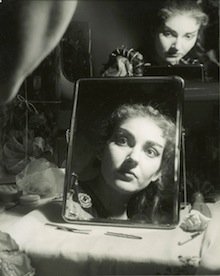
The miraculous scenes from the 1964 Paris Act 2 Tosca, pairing Callas with Tito Gobbi and staged by film and opera director Franco Zeffirelli, give us our clearest sense of her ability to make a momentous event of every second onstage. Equally amazing is her transformation in this 1962 concert performance, from Hamburg, of excerpts from Bizet’s Carmen. Although Callas seems a bit self-conscious as the overture begins, she becomes increasingly absorbed as she ruminates on her future conquest of Don José. Every glance, every slight turn of the lips contains meaning. She delivers the “Habanera,” which some performers render as a simple, catchy ditty, with such a wealth of nuance that each note is significant. Standing in place without costume, Callas is the essence of operatic genius.
One of my favorite Callas live aria excerpts, broadcast on Nov. 27, 1956, from the RAI (Radio Italiana) studios in Milan, is “Tu che invoco” from La vestale. The first half of the aria is constructed of blocks, which Callas places as would a master architect. As befits the music, her voice is classically constrained, yet filled with terror and torment. Then, in the rapid final cabaletta, voice and artistry break loose. Notes tumble forth like venom, as immensely challenging scale passages, negotiated with astounding weight and ease, express the Priestess’ desperate plea to the gods. The effect is ravaging.
Contrast this with the light, limpid scales of the “Mad Scene” from Callas’ incomparable 1955 live Berlin Lucia, with Herbert von Karajan conducting. Who else on record has ever been able to encompass these extremes, let alone do so with such mastery? Who else has even dared try?
Callas imbued a host of bel canto rarities ... with a stylistic authenticity and vocal and histrionic power that had not been heard since the previous century.In the spinto and verismo repertoire, Callas seems to have learned as much from the examples of her predecessors as she did from her prime teachers: the retired coloratura Elvira de Hidalgo, with whom she studied at the Athens Conservatory between the ages of 16 and 21, and maestro Tullio Serafin, who insisted that she could sing both dramatic and bel canto coloratura roles. Both were keepers of the old tradition, with links to the great teachers of the 19th century.
To illustrate this point, I include two versions of “Ebben? Ne andrò lontana,” from Catalani’s La Wally, which is the centerpiece aria in the 1982 movie Diva. In addition to Callas’ famed studio recording, I’ve also included the heartbreaking 1920 Edison Diamond Disc version by Claudia Muzio.
Muzio, known as La Divina (The divine one), opened the San Francisco War Memorial Opera House in 1932 in the title role of Puccini’s Tosca. The impact of many of her recorded performances, including her reading of the letter and “Addio del passato” from La traviata, can be heard in Callas’ recordings. Regardless of whether Callas had actually ever heard her great predecessor’s recordings, it’s clear that she understood the style extremely well.
Praise From Colleagues
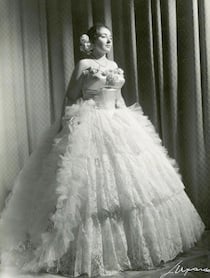
Mezzo-soprano Frederica von Stade, whose long career included several Rossini roles and an exquisite San Francisco Opera run of the mezzo version of one of Callas’ most famous roles, Amina in Bellini’s La sonnambula, shared this with me about Callas:
Callas’ magnificence lay in both her natural gift and her incredible commitment to mastering the correct style with the great conductors that she worked with. All the things that you think are happening spontaneously are planned and organized. They’re part of the style. Her stylistic mastery, as well as her personality and voice, still make people talk today. It’s that magic thing that happens.Whatever genius is, I think there’s a strong element of genius in [Callas].
I didn’t dare study her phrasing, but of all the singers I listen to, it’s Callas I love most. I always have. And I was lucky enough to be at the Met[ropolitan Opera] when she did the master classes at Juilliard [School]. I saw them, and saw how she worked with people and what her knowledge was. There was no mystery to it. It was very tangible. The grounding was sort of like a ballerina’s footing in barre exercises. To get to the point where you get your feet to leap into the air, you have to begin very close to the floor. That’s what I think a lot of her musicianship represents to me: It’s her extraordinary devotion.
Coloratura soprano June Anderson, whose San Francisco recital for “Lieder Alive!” a few months back included a model performance of Bellini’s “Casta Diva” from Norma, was unstinting in her praise when I asked her about Callas:
I happen to think that Callas was the greatest singer of the 20th century. I feel that so many people have learned the wrong things from her, rather than the right things. She was a fabulous musician. When you listened to her, you could almost take dictation. All the dots were there. Anything that was wrong was because of the deterioration of the instrument over time. But usually musical things were not wrong. She has pitch problems and wobbles that came in later.Callas was such an example of professionalism. One thinks of her as a flighty diva, which is the wrong thing to learn from her, and she wasn’t at all.
From Callas, I learned to respect the music. It’s part of the attention to detail. Today, everything seems to me a bit homogenized. Puccini sounds like Handel which sounds like Bellini. Callas had this sense of style, whether it was learned or just innate.
Callas was superhuman. She was on a whole other plane. She really was a Diva — the goddess — and the rest of us are basically her handmaidens.
Another admirer, and an intimate, Franco Zeffirelli, who created some of Callas’ most famous productions and continues to bolster her legend, spoke to John Ardoin and Gerald Fitzgerald for their invaluable, lavishly illustrated book Callas:
The magic of a Callas is a quality few artists have: something special, something different. There are many very good artists, but very few who have that sixth sense, the additional, the plus quality. It is something which lifts them from the ground, they become like semigods. She had it.
The Arc of the Career
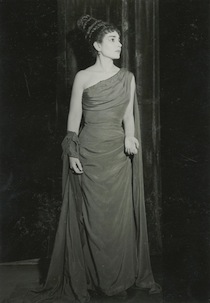
Maria Callas made her professional debut at the Arena di Verona in spring 1947, singing the lead in Ponchielli’s La gioconda. Two years later her fame spread when, in Venice, she alternated the dramatic role of Brünnhilde in Wagner’s Die Walküre with the high-lying coloratura role of Elvira in Bellini’s I Puritani. Not since the heyday of Lilli Lehmann (1848–1929), who alternated Wagner’s Brünnhilde with Mozart’s most demanding coloratura roles, had anyone successfully pulled off such a feat.
That same year, in Naples, Callas sang the dangerous role of Abigaille in Verdi’s Nabucco, with astounding volume and sensational coloratura. This is the role that wrecked Elena Suliotis’ voice, and that did Leontyne Price no damage because, when Met General Manager Rudolf Bing asked her to sing it, she replied with something like, “Man, do you think I’m crazy?!”
The following year in Rome, Callas repeated her near-impossible feat by successfully alternating Wagner’s Isolde with Bellini’s Norma. Again and again, through 1952, she flabbergasted audiences with her range and technique. Do not miss the famed interpolated high E-flats (and even higher) in the Mexico City performances, and the phenomenal coloratura and interpolated highs in Rossini’s Armida at the 1952 Florence May Festival. Callas became a more subtle and expressive singer in the years that followed, but she was never again able to take the risks that became the norm in the first five years of years of her professional career.
From here followed the great collaborations with film directors Luchino Visconti and Zeffirelli, plus the live and recorded triumphs conducted by Serafin, de Sabata, Giulini, von Karajan, and Bernstein. Callas introduced virtually all her new roles at La Scala, where she sang 180 performances in 22 operas. From 1953 on, she rarely performed in other Italian houses, and limited her appearances outside Italy. Wherever she sang, all eyes and ears were on her.
The Ultimate Tragedy
Vissi d’arte, vissi d’amore ...
Nell’ora del dolore perché,
Perché Signore, perché me ne rimuneri così?
I lived for art, I loved for love ...
In this hour of pain, why,
Why, oh Lord, why do you repay me thus?
— Floria Tosca
Callas’ triumph was short-lived. By the end of the 1950s, Callas had dramatically truncated her appearances in opera, and instead presented a limited number of gala recitals. After a series of rapturously received but undeniably flawed performances in 1964, she cut short her Norma run in 1965, then sang her final Tosca at Covent Garden on July 5. She was six months shy of her 42nd birthday.
Standing in place [in a recital] without costume, Callas is the essence of operatic genius.Many observers have suggested that Callas’ voice and technique were basically sound, and offer various theories for her premature decline.
“When I listen to some of the concerts from ’74,” June Anderson told me, “I don’t hear that the voice is gone. It’s her confidence that’s gone, as far as I’m concerned. Callas, no matter if what she did was right or wrong, always did everything with such authority that you believed it. In 1974, in those concerts, she was almost apologizing for every note she sang. So I don’t think the voice was gone. She’d been traumatized by everything that went on in her personal life, and her voice never got over it.”
There is truth here. But, listening closely, you can hear, even in the early live performances, a tendency to wobble when the voice is asked to sustain tones without forward momentum. (A case in point is an early live performance of “Depuis le jour.”) Callas’ voice was, in fact, conquered and controlled by sheer will.
When that will faltered, a voice that had already been eroded by a combination of (a) a dangerous tendency to carry her chest voice into the middle range for dramatic effect; (b) too-rapid weight loss; (c) a pattern of transforming the stage into an arena for personal psychodrama (listen to Callas scream her way through Cherubini’s Medea in Dallas right after she received Rudolf Bing’s telegram firing her from the Met, and watch the between-acts interview with the press for evidence of this phenomenon); and (d) the psychological pressure generated from being dubbed “The Tigress” by the press. The decline was accelerated by utter nonsense, such as the newsreel that misrepresented old footage to suggest that Callas had capriciously walked out on the president of Italy, when in fact she was ill and there was no understudy to take her place.
Callas may have been a thorough professional, but she was also the eternal victim. No wonder she was so good at bringing victims to life onstage. Watch, for example, Edward R. Murrow’s infamous Jan. 24, 1958, interview with her, conducted three weeks after the walkout. Murrow starts out laudatory, then begins to lure her into the trap. Callas sets herself up for the kill by literally feeding Murrow the bait before doing her best to squirm free. It's a narrow escape.
Callas and Her Time
Callas was also extremely myopic. Her stare was extremely intense, because she literally could not see where she was going. When on more than one occasion she stared down a hostile audience and turned it around, she actually couldn’t see a thing; the triumph was achieved by sheer force of will.
“Whatever genius is, I think there’s a strong element of genius in [Callas].” – Frederica von StadePsychologically, Callas’ myopia translated into a diva unable to “see” the consequences of her individual actions, let alone their cumulative impact. Hence she could seem strangely disconnected from the trail of controversies her actions helped generate. She saw her own every move onstage, but saw far too little beyond the proscenium. Thus she could praise her husband to Murrow, then leave him the following year during her cruise on the Onassis yacht, Christina.
The tendency of the press to skewer Callas must be understood in the context of two historic developments in the U.S. in the late 1940s and 1950s: the McCarthy witch hunts, and the post–World War II shift in employment. Callas emerged during an era in which the world watched Senator Joseph McCarthy as he strove to uncover a communist under every bed in the nation. It was also a time when women were being encouraged to forsake the factories and workplaces into which they had been recruited during the war effort, to instead become model, stay-at-home, subservient housewives.
Into this milieu strode an American woman with a controversial voice, and an even more controversial history of confrontations and cancellations. Instead of playing meek and subservient, Callas stared down audiences when they booed or gasped at her vocal flaws, stood up to opera administrators, and played defiant victims and vengeful murderers onstage. The press was of the mind-set to get people, and Callas was the perfect target.
Watch the Murrow interview and then read her own defense in Life magazine the following year, viewers and readers saw the enormous pressure she was under. Is it any wonder, as the voice and spirit were faltering and the tide was turning, that the woman who made of the stage an arena for conquest looked, instead, for a way out? Hence the decision, on the fateful 1959 trip on the Christina, to leave her husband and protector, Meneghini, and instead embrace the high-society life of the billionaire Onassis.
What Callas could not embrace was her own salvation. Ultimately, she could not see a way out. This is the essence of her tragedy. The woman who transformed the world of opera was unable to turn her own life around. Even as we honor her artistry, and admire her continued impact on the evolution of opera, we weep for the pain she endured.
For refreshing and deepening my understanding of Callas’ uniqueness, I am indebted to bel canto expert, conductor, and former New York Times critic Will Crutchfield. He kindly sent me the unedited 24-page manuscript for “The Life and Deaths of Maria Callas,” an exhaustively researched article he prepared for the Nov. 1995 issue of The New Yorker, and answered several questions via email.

